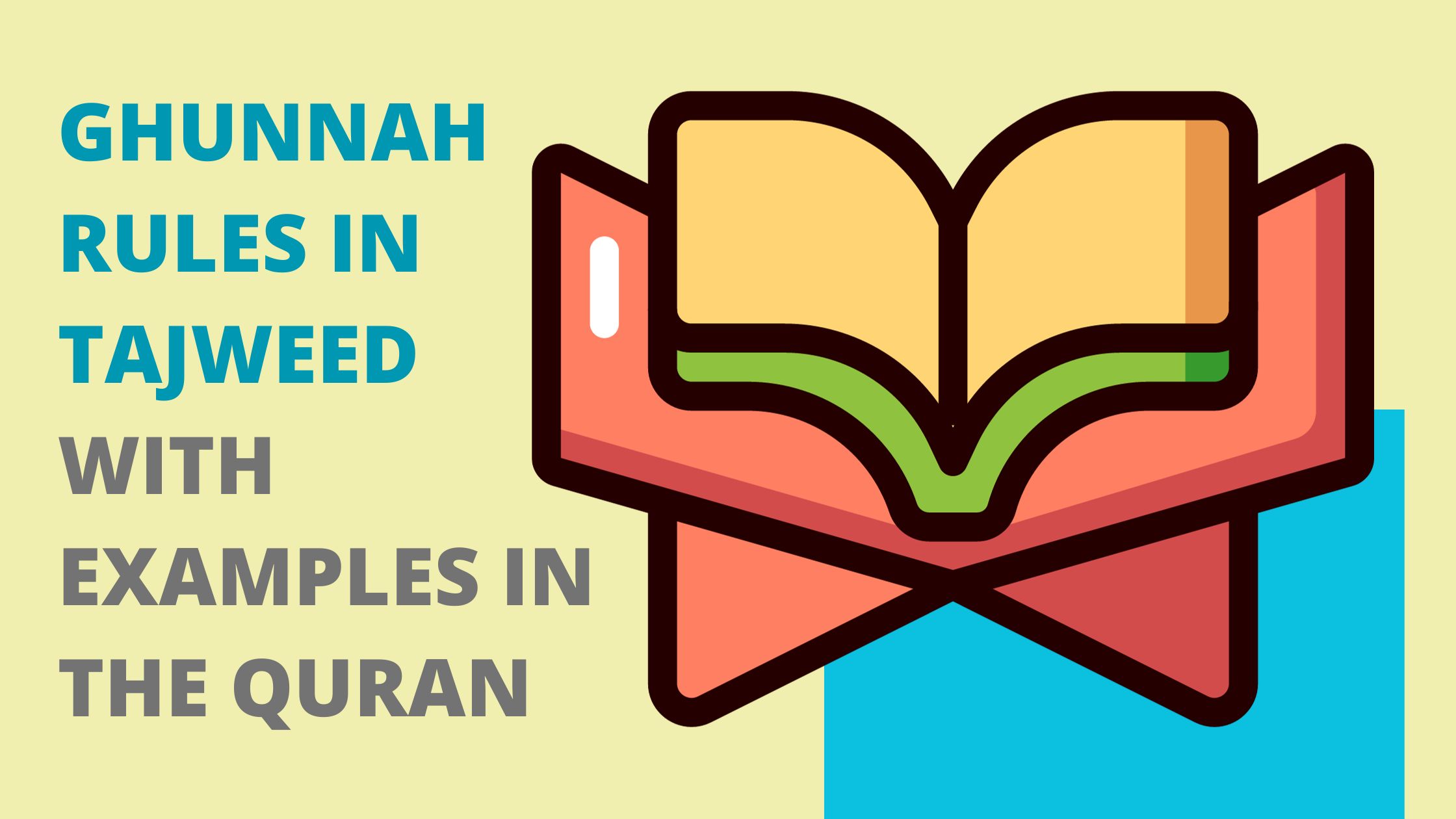In this article, we will delve into the intricate rules of ghunnah in Tajweed. Ghunnah is an essential aspect of proper recitation of the Quran, as it adds beauty and melody to our voices while reciting the holy words.
Understanding the definition, letters, rules, types, and examples of Ghunnah in the Quran is crucial for anyone striving to perfect their recitation and deepen their connection with the divine text. So let us begin our journey into mastering this important element of Tajweed.
Table of Contents
What is Ghunnah in Arabic?
The term “Ghunnah” in Arabic refers to nasalization, which occurs when sound is produced by the vibration of vocal cords while airflow is partially diverted through the nose.
In Arabic phonetics, Ghunnah specifically applies to the letters ن (Noon) and م (Meem), especially when they bear a Shaddah or appear in a Noon Sakinah or Meem Sakinah form.
1. Definition and Pronunciation in Arabic:
Ghunnah is the sound produced when air passes through the nasal cavity during the pronunciation of certain Arabic letters.
It is important to note that Ghunnah does not involve any other parts of the articulation system, making it a distinct feature of Arabic phonetics.
An interesting way to test the pronunciation of Ghunnah is to try pronouncing it with your nose closed, revealing its dependence on nasal airflow.
2. Historical Significance in Arabic:
The Arabic language has always placed great importance on precise pronunciation, and Ghunnah has been a part of this linguistic tradition for centuries.
It is considered an essential aspect of proper pronunciation, particularly when dealing with the letters Noon and Meem.
Mastering the correct pronunciation of Ghunnah is crucial for learners of Arabic who wish to communicate effectively and accurately.
Give your child the gift of proper Arabic pronunciation with Bayan Al-Quran’s online Arabic course for kids.
What is Ghunnah in Tajweed?
In Tajweed, Ghunnah refers to the nasalized sound produced when pronouncing the letters Noon (ن) and Meem (م) with a Shaddah.
1. Significance in Tajweed:
This nasalization is an important aspect of proper Quranic recitation, as it helps to maintain the correct pronunciation and preserve the beauty of the words revealed in the Quran.
2. Duration in Tajweed:
The Ghunnah sound in Tajweed lasts for two counts, meaning it is held for a specific length of time during recitation.
3. Application in Tajweed:
It is important to note that Ghunnah is only applied when there is a Shaddah on the Noon or Meem, indicating the doubling of the consonant sound.
4. Historical Importance:
The rules of Ghunnah in Tajweed were likely formalized during the early stages of Islam to ensure the accurate transmission of the Quranic text.
Prophet Muhammad himself was known for his meticulous recitation, and the preservation of the Ghunnah sound played a crucial role in maintaining the authenticity of the Quran.
5. Learning and Mastering Ghunnah:
Mastering the correct pronunciation of Ghunnah in Tajweed requires practice and guidance from qualified teachers at At Bayan Al-Quran.
Through the study of Tajweed, learners can develop a deeper understanding of the rules Tajweed Rules for Heavy and Light Letters and techniques necessary for proper recitation, including the precise application of Ghunnah.
Letters of Ghunnah in Tajweed
Ghunnah letters, including meem (م) and noon (ن), as well as Tanween, create a distinct sound when pronounced with the airflow through the nose. Understanding the letters of Ghunnah is crucial for accurate pronunciation in Arabic, especially in Quranic recitation.
1. Nasal Resonance:
The Ghunnah sound resonates in the nasal cavity, producing a humming or buzzing sound.
2. Duration:
The Ghunnah sound typically lasts for about two counts in Tajweed, maintaining the rhythm and melody of Quranic recitation.
3. Intensity:
The intensity of the Ghunnah varies based on the context of the letters, being more intense when associated with a Shaddah.
4. Letters Involved:
Ghunnah is specifically associated with the Arabic letters ن (Nun) and م (Meem) when in a non-vocalized state (Sakin) or accompanied by a Shaddah.
5. Vocal Cord and Nasal Activity:
To articulate the Ghunnah, the vocal cords vibrate while the airflow is directed through the nasal passage, creating a nasalized sound.
6. Articulatory Process:
The back of the tongue slightly elevates towards the soft palate, the velum lowers, and the lips and oral cavity shape according to the specific letter, but the sound’s resonance is primarily nasal.
Mastering Noon Saakin and Tanween in Tajweed rules requires practice. The more you practice, the better your recitation will become.
Rules of Ghunnah in Tajweed
Understanding the rules of Ghunnah in Tajweed is essential for proper Quranic recitation. There are four ranks or levels of Ghunnah, each with its own set of rules and examples:
1. The Most Complete Ghunnah:
This is the longest form of Ghunnah and occurs with Meem Mushaddad and Noon Mushaddad. It lasts for 2 counts and examples can be found in verses like “عَمَّ يَتَسَاءَلُون” and “كَلَّا إِنَّهَا تَذْكِرَة”.
It also applies to Idgham with Ghunnah, where Noon Saakin or Tanween merge into the following letter accompanied by the sound of Ghunnah, as seen in the verse “فَمَن يَعْمَلْ مِثْقَالَ ذَرَّةٍ خَيْرَاً يَرَه”.
2. The Complete Ghunnah:
This rule comes after the most complete Ghunnah and applies to Noon Saakin or Meem Saakin followed by Ikhfaa letters. They are hidden in the next letter with a combination of Izhar and Idgham, along with the sound of Ghunnah.
For example, Ikhfaa with Meem Sakinah before the letter ب in successive words, such as “أَلَمْ يَعْلَم بِأَنَّ اللهَ يَرَى”. Similar rules apply to Noon Saakin and Tanween followed by certain letters like صف ذا ثنا كم جاد شخص قد سما دم طيباً زد في تقى ضع ظالما.
Examples of Ikhfaa with Ghunnah can be found in verses like “مِن شَرِّ مَا خَلَقَ” and “أَوْ إِطْعَامٌ فِي يَوْمِ ذِي مَسْغَبَة”.
3. The Incomplete Ghunnah:
In this case, the Ghunnah is shorter and less prevalent than the previous ranks. It occurs when Noon Saakin or Meem Saakin are in a state of Izhar or clear pronunciation.
For example, when Noon Saakin comes before Izhar letters like ء – هـ – ع – ح – غ – خ in the verse “فَصَلِّ لِرَبّكَ وَانْحَر”.
Meem Saakin is pronounced with an incomplete Ghunnah before any letter except ب and م, as seen in the verse “الذَينَ هُمْ عَن صَلَاتِهِم سَاهُون.
4. The Most Incomplete Ghunnah:
This is the shortest form of Ghunnah and coincides with the presence of Noon and Meem with Harakah (Dummah, Fatha, or Kasrah). Examples include verses like “فَوَسَطْنَ بِهِ جَمْعَا” and “لَا أَعْبُدُ مَا تَعْبُدُونَ”.
By understanding these rules of Ghunnah in Tajweed, one can ensure proper pronunciation and preserve the meaning of Quranic verses.
Unlock Your Child’s Spiritual Potential with Online Quran Learning at Bayan Al-Quran Academy
At Bayan Al-Quran Academy, we offer online Quran learning for kids through one-on-one classes with experienced teachers.
Our interactive and engaging curriculum covers Tajweed rules, memorization of Surahs, Arabic vocabulary, and developing a deep connection with Allah.
With flexible scheduling options and personalized attention, your child can learn the Quran at their own pace from the comfort of their home. Enroll them today and witness their spiritual growth unfold before your eyes.
Conclusion
Unlocking the secrets of Tajweed and mastering the rules of Ghunnah is a crucial step towards understanding and reciting the Quran with precision and beauty. The concept of Ghunnah in Arabic carries historical significance, while its application in Tajweed holds immense importance for proper pronunciation.
By learning about the letters involved, the duration, intensity, and articulatory process of Ghunnah, one can effectively apply the rules to achieve different types of Ghunnah. Whether it’s the Most Complete Ghunnah or the Most Incomplete Ghunnah, each variation adds depth to our recitation.
At Bayan Al-Quran Academy, we believe that online Quran learning provides an excellent opportunity to unlock your child’s spiritual potential by delving into Tajweed principles such as Ghunnah. Join us on this enlightening journey today!

















